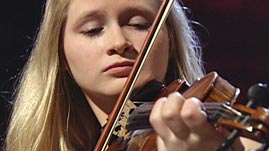Teachers' Domain - Digital Media for the Classroom and Professional Development
User: Preview


Source: From the Top at Carnegie Hall: "Family Ties"
You can see the full episode and a more complete lesson plan at the From the Top at Carnegie Hall Web site.



Exclusive corporate funding provided by Liberty Mutual. Additional funding provided by the Bernard Osher Foundation, the Jack Kent Cooke Foundation, the National Endowment for the Arts, Helen and Peter Bing, and the E.H.A. Foundation.
In this performance video segment from From the Top at Carnegie Hall, violinist Caeli Smith plays "Bordel 1900" from Astor Piazzolla's L'histoire du tango ("The History of the Tango"), accompanied by pianist Christopher O'Riley. Originally written for flute and guitar, this version was arranged for violin and piano by Tim Ribchester. Listen for rhythmic patterns that are repeated throughout the song and imagine how dancers would tango to the piece.
In the supplemental video segment, Caeli Smith and Christopher O'Riley work with Pablo Ziegler, a pianist who collaborated with Piazzolla for many years and carries on his musical legacy.
Mad Hot Tango: Caeli Smith Rehearsal (Video)
Astor Piazzolla was a major influence on the development of the tango style during his long career, which began in the 1930s and ended with his death in 1992. Born in Argentina to Italian immigrant parents in 1921, he was playing and composing tango music by the time he was in his late teens.
The tango originated in the dance halls of Buenos Aires in the late 19th century and was a well-established and beloved hallmark of Argentinean popular music by the time Piazzolla began his career. But Piazzolla's great musical curiosity and versatility (he also composed in classical and jazz styles) drew him to experiment with the "classic" tango form (to the dismay of some purists!). In 1953, he won a prestigious competition for composers and went to Paris to study with the great teacher Nadia Boulanger. She recognized his unique musical vision and encouraged him to express it. The result was nuevo tango, music that incorporated classical and jazz elements into the tango form, drawing musicians and music lovers of many tastes into its spell.
Many kinds of classical music originated as dance forms. In Bach suites, for example, there are typically movements called gigue, sarabande, bourrée, and courante, all based on dances. ("Gigue" is the familiar jig!) Other popular dance forms used in later classical works include the waltz and the flamenco (a Latin dance). Many dance rhythms use syncopation (a stress on a normally unstressed beat, or no stress where one is expected) to create a sense of strong forward momentum. Classical music often contains syncopated rhythms, as do jazz and popular music (such as George Gershwin's "Fascinating Rhythm"). Listen for the syncopation in "Bordel 1900."
In addition to being a serious violinist, Caeli Smith is one of From the Top's Roving Reporters, producing audio interviews for the radio show and writing for From the Top's monthly newsletter. To read more about Caeli, hear her radio show performances, and read her articles, check out From the Top.
National Music Standards: Content Standard 7: Evaluating music and music performances
 Loading Standards
Loading Standards